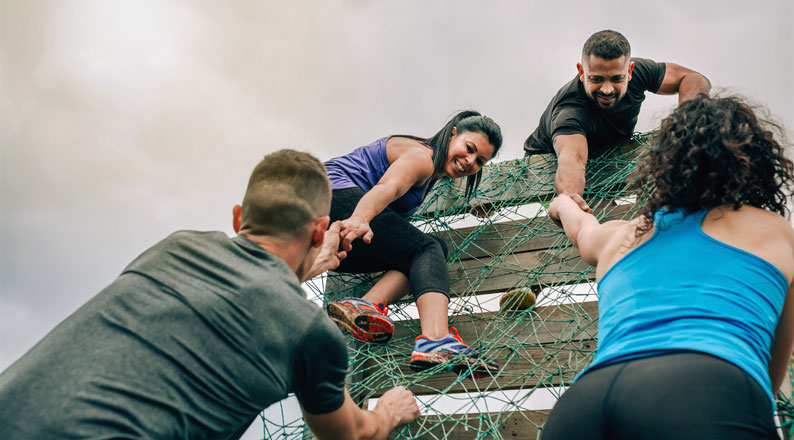
The appearance of U.S. Department of Defense (DoD) visual information does not imply or constitute DoD endorsement.
One of the most straightforward ways to become an officer in today’s American military is through the Reserve Officers’ Training Corps – ROTC.
But what is the ROTC? The ROTC is a blanket program describing a partnership between different military branches and civilian colleges, bundled with a variety of attractive scholarship opportunities for students. ROTC puts military training and coursework together with regular undergraduate degree programs. Taught by both military and civilian instructors, you get an education in both the major of your choice and fundamental leadership and tactical skills.
After graduation, you are commissioned as an officer with the obligation to serve for certain number of years, typically eight. Although “Reserve” is right there in the title, most ROTC graduates fulfill about half their obligation through active duty service and the rest in reserve status.
Just over half of all active duty officers are commissioned through ROTC programs.
ROTC scholarships can be one of the best ways to have Uncle Sam help fund your college education. While your service obligations are practically the same as any enlisted service member, you get to start off with the benefit of a college degree. And you will still earn the same GI Bill® and other veteran’s education benefits along the way.
What Does ROTC Stand For in American Society?
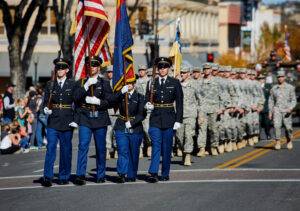 The ROTC – Reserve Officer Training Corps – is a continuation of a long and distinguished legacy of citizen soldiers in the United States. From the militia stand at Lexington and Concord to the Volunteer Regiments that made up the bulk of the forces engaged on both sides in the Civil War, the idea that the nation’s warriors should first be drawn from civilian society is woven into American military tradition.
The ROTC – Reserve Officer Training Corps – is a continuation of a long and distinguished legacy of citizen soldiers in the United States. From the militia stand at Lexington and Concord to the Volunteer Regiments that made up the bulk of the forces engaged on both sides in the Civil War, the idea that the nation’s warriors should first be drawn from civilian society is woven into American military tradition.
That officers should have higher education has always been part of that package. In fact, the combination of civilian college instruction and military training stretches back to at least the Civil War. The Morrill Act establishing the original land-grant colleges that became today’s public university system required those schools to offer military tactical instruction along with other courses.
ROTC was formally established in 1916 as World War I raged in Europe. Harvard University hosted the very first ROTC unit. Over 17,000 officers had come through the program by the time the U.S. joined the war. They formed the core of forces sent overseas.
Today, more than 1,700 colleges and universities across the United States offer ROTC. Some 30,000 cadets study in ROTC programs, and 6,000 new officers are minted from them each year. As many as 80 percent of the second lieutenants entering service come out of ROTC training.
ROTC is not as intensive as the service academies like West Point and Annapolis. But it’s more integrated with a college education than Officer Candidate School or Officer Training School.
The Reserve Officers’ Training Corps is the next best thing to a service academy.
Most importantly, it allows officers to build and maintain strong ties to their future civilian careers as well as to the military. You’ll have one foot in the service and one stepping toward your civilian career. It’s a civic choice as well as an educational one. And that’s to the benefit of both the military and civil society.
Not every service offers an ROTC path. The Army, Navy, and Air Force each run ROTC programs. Space Force and Marine commissions can be earned through the Air Force and Navy programs, respectively, however. That leaves the Coast Guard as the odd man out. But the Coasties do have a JROTC (Junior Reserve Officer Training Corps) program, and they run the College Student Pre-Commissioning Initiative (CSPI) scholarship program that offers a similar path to commissioning. You can learn more about CSPI in our Branch-Specific Military Education Benefits Guide.
What is ROTC in High School?
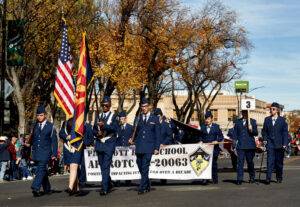 If you just can’t wait for college to get a taste of the military lifestyle and training, you may be in luck. There are more than 3,200 Junior Reserve Officers’ Training Corps programs in high schools around the country – that’s twice as many as the number of college programs!
If you just can’t wait for college to get a taste of the military lifestyle and training, you may be in luck. There are more than 3,200 Junior Reserve Officers’ Training Corps programs in high schools around the country – that’s twice as many as the number of college programs!
These units are usually headed up by retired military personnel and offer activities like drill, orienteering, marksmanship, and even marching band or model rocketry. They are designed to foster physical fitness and strong character and citizenship qualities.
But they are also a great gateway into regular ROTC programs. Nothing says commitment to review boards considering scholarship applications like JROTC classes on your transcript.
JROTC usually comes with some unique extracurricular activities, as well. Visits to military bases, summer leadership academies, and physical and knowledge-based competitions are common.
Even branches that don’t run their own ROTC programs, like the Marines, Space Force, and the Coast Guard, offer JROTC.
Does ROTC Pay for College? – ROTC Scholarships Explained
ROTC comes in two options: scholarship and non-scholarship.
Clearly, it’s to your benefit to get an ROTC scholarship rather than footing the cost of college on your own. On the other hand, if you aren’t quite sure that military life is for you, non-scholarship options give you a chance to try it out before you commit.
In general, you can enroll in lower-division ROTC courses during your first two years of college without taking on any military obligation… but also without getting any scholarship money.
Scholarships come in two, three, and four-year varieties. Each of them offers full coverage for tuition and fees, along with a fixed annual payment to cover books and supplies, and a monthly living stipend paid to you directly. Some programs offer the option to cover room and board instead of tuition. And in some cases, schools that host ROTC programs offer their own unique benefits.
The two- and three-year programs are designed for people who are already enrolled in college and decide to opt for ROTC only after trying it out. Once you commit (and are accepted), they pay for the remainder of your schooling.
Four-year scholarships are aimed at people coming right out of high school. If you make that commitment, you can get a full ride and a 100 percent guaranteed job after graduation in either the active duty force or reserves.
ROTC Requirements Balance Both Academic and Physical Achievement
 The first requirement for getting into ROTC involves picking a school that offers it. You’ll find ROTC programs at small liberal arts schools and big regional research universities, but there are nearly 4,000 college and universities in the country, and only about half have ROTC options.
The first requirement for getting into ROTC involves picking a school that offers it. You’ll find ROTC programs at small liberal arts schools and big regional research universities, but there are nearly 4,000 college and universities in the country, and only about half have ROTC options.
There are a handful of private military colleges that still exist in the United States. Academies like The Citadel and Virginia Military Institute are organized and run like a service academy. But in fact they are just Army ROTC programs that have gone all-in on military education.
Each branch has their own priorities and specific requirements for awarding scholarships. In general, you will need:
-
To be a U.S. citizen between the ages of 17 and
- 26 (Army)
- 23 (Navy)
- 31 (Air Force)
- Have a high school diploma or GED and a cumulative GPA of at least 2.5
- Meet the required physical fitness standards for your branch
- Have no medical issues preventing service
But the ROTC scholarship application process is competitive. Just meeting the minimums isn’t enough. According to Navy statistics from 2017, for instance, the average recipient had an SAT composite score of 1434, a cumulative GPA of 3.83, and nearly 90 percent were enrolled in technical majors. More than 20 percent came in with JROTC experience.
Additionally, you’ll have to interview as a part of the application process. This carries a lot of weight, so you’ll want to be clear on your intentions and obligations. If you are already enrolled and attending school, your college GPA will also be taken into account.
ROTC scholarships are open to graduate students, too. If you already earned a bachelor’s degree on your own and are interested in joining the military in a role that requires graduate-level education, you can find ROTC opportunities at that level to fund a master’s degree.
The Navy and Air Force both heavily favor applicants in certain majors. The Navy further ranks their majors by demand into three groups. Those in the top two tiers are more likely to be chosen based on the needs of the service.
In both cases, different levels of scholarship support are offered based on your major. That choice may restrict payment to in-state tuition rates, or come with a total ceiling on annual payments. Or it may put you out of the running for a scholarship at all.
College ROTC Programs Keep The Heat on For Academic, Physical, and Moral Standards
 Standards are high – not just for getting into ROTC, but for staying in. If you were thinking you were going to follow the all-too-typical college student path of parties first, academics second, think again. You will have to keep your grades up, behave with integrity and honor, and hold to a kind of military discipline. Physical standards are important too, so it’s wise to make time for hitting the gym daily.
Standards are high – not just for getting into ROTC, but for staying in. If you were thinking you were going to follow the all-too-typical college student path of parties first, academics second, think again. You will have to keep your grades up, behave with integrity and honor, and hold to a kind of military discipline. Physical standards are important too, so it’s wise to make time for hitting the gym daily.
Prior Enlisted ROTC is a Different Ballgame
ROTC is also used by the military as a pathway for currently enlisted soldiers to earn promotion to officer ranks. Among several different enlisted-to-officer programs, each branch has a number of opportunities that can pluck enlisted personnel from the ranks and send them off to a civilian college with or without a scholarship. They go through the same classes and receive the same commission and obligations as other ROTC students.
Applying for and being accepted to these programs is a very different process, however. You can see more about the various ROTC options for active duty service members in our Active Duty Military College Benefits Guide.
Army ROTC: Scholarships and Format
- Schools: More than 1,000
- Stipend: $420/month
- Supplies: $1,200/year
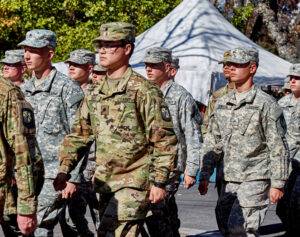 Army ROTC is the largest of the ROTC programs. It’s the only one available at private military schools. But it also offers the greatest number of scholarships to the greatest number of students. Your odds for getting an Army ROTC scholarship are better than any other branch.
Army ROTC is the largest of the ROTC programs. It’s the only one available at private military schools. But it also offers the greatest number of scholarships to the greatest number of students. Your odds for getting an Army ROTC scholarship are better than any other branch.
Your college experience will consist largely of courses in your major. And the Army doesn’t restrict what that major is.
Army ROTC uniform days occur a couple times a week, typically. You’ll take one ROTC elective class and one practical lab each semester. These are organized by class:
Basic Course
This is the introductory set of classes for freshmen and sophomores. This gets you familiar with military life and lays the groundwork for leadership skill development. These classes teach you a bit about the service and essential skills like:
- Map Reading
- First Aid
- Leadership
- Small Unit Tactics
Basic Camp
Basic camp is an alternative to the Basic Course for students who didn’t take those classes before their junior year. In a paid four-week summer course at Fort Knox, you’ll get a cram-course in all the military essentials taught in the Basic Course.
Advanced Course
To take the advanced course, you’ll have to sign a service contract regardless of scholarship status. In return, you are taught subjects such as:
- Advanced Land Navigation
- Advanced Practical Leadership and Small Unit Tactics
- Marksmanship
- Leadership Development
Advanced Camp
Your junior summer will see you off to Fort Knox for five weeks of intensive weapons training, rappelling and team obstacle courses, patrol training, and water safety instruction. Completion of Advanced Camp is mandatory for commissioning.
Advanced camp is also where the fun begins. The Army really wants to get you revved up for service. So you’ll get exposed to a wide array of leadership experiences and even opportunities to jump start your functional skill qualifications through a program called Cadet Professional Development Training.
CPDT sends you off to cool stuff like:
- Cadet Troop Leader Training - Embed with a real active duty Army unit as a platoon leader.
- Advanced Camp OpFor - Have fun on the other side playing the bad guys going up against Advance Camp squads and platoons in tactical training.
- Cadet Advanced Individual Training - Get sent off to a variety of qual courses and schools ranging from Airborne to Mountain Warfare to Combat Diving; come home with the badge to prove it.
- Internships - Spend your summer with an active duty unit in specialized technical fields like engineering, intelligence, and cyber defense to get hands-on experience in real-world duties.
- Cultural Understand and Leadership Program - Deploy overseas to one of more than 26 different countries to support combatant command security cooperation efforts… and see the world.
- Nurse Summer Training Program - A one-month assignment to a CONUS or overseas Army hospital offers a taste of what the Nurse Corps is all about, and offers hands-on training to hone your clinical skills.
Your senior year offers advanced classroom training in command and leadership skills. You’ll also take the cadet leader course and develop skills through counseling younger cadets. Most importantly, you’ll apply for your branch choices of interest and start receiving branch-specific training.
Air Force ROTC: Scholarships and Format
- Schools: ~145 (More than 1,110 through cross-town hosting agreements)
- Stipend: $300-500/month based on grade level
- Supplies: $1,200/year
AFROTC starts you off with the General Military Course, with the same basic pattern each week for your first two years:
- 1 hour classroom studies
- 2 hours leadership laboratory
- 3 hours physical conditioning
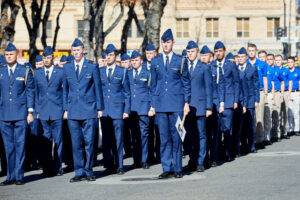 Your aerospace studies courses teach you the history of the Air Force and fundamentals of leadership and communication. That’s all on top of your regular major coursework.
Your aerospace studies courses teach you the history of the Air Force and fundamentals of leadership and communication. That’s all on top of your regular major coursework.
If you make it through GMC, you’ll be eligible to compete for POC, the Professional Officer Course that caps off AFROTC. This is far from automatic: the POC selection system evaluates factors such as:
- Grade point average
- Aptitude and PT test scores
- In-person evaluation
If you are selected for POC, you’ll be shipped off to Maxwell Air Force Base for an intense four-week summer field training exercise. This is your boot-camp equivalent, with days packed with PT, marching, combative training, and detailed instruction on how to make your bed and fold your underwear. You’ll be evaluated for your performance under pressure and your leadership skills.
The second half of Field Training happens at Vigilant Warrior, a 200-acre training area where you’ll go through deployment training and tackle obstacle courses in intense team-building experiences.
ROTC Field Training Teaches Valuable Survival Skills
 Captain Scott O’Grady had been living on bugs and plants and rainwater for almost a week as he crouched in the dim woods of Western Bosnia listening for the chunky whine of Sea Stallion rotors approaching.
Captain Scott O’Grady had been living on bugs and plants and rainwater for almost a week as he crouched in the dim woods of Western Bosnia listening for the chunky whine of Sea Stallion rotors approaching.
Six days earlier, O’Grady’s F-16, callsign Basher-52, had taken an SA-6 to the gut during an Operation Deny Flight patrol enforcing the NATO no-fly zone over Bosnia and Herzegovina. O’Grady barely had time to eject as the aircraft came apart in flight. He’d been burned on his face and neck and been shot at by Serb patrols not long after his parachute landed. For days, it had been too risky to try to contact American forces for rescue as he was hunted through the woods.
But O’Grady had something going for him: his Air Force ROTC training had offered more than just survival skills and information about what bugs to eat. It had also instilled him with grit, discipline, and determination.
As the choppers arrived, O’Grady popped smoke and sprinted from cover. He got to the birds so fast that Marines in the rescue helicopter never even had a chance to get out to cover him. Physical fitness, coolness under pressure, and faith in comrades are all key parts of what AFROTC offers every cadet.
 In POC, you keep the PT commitment but dive into deeper leadership skills training and national security and defense studies. Even if you’re not on an AFROTC scholarship, if you’re accepted to OPC you’ll start receiving monthly stipend payments.
In POC, you keep the PT commitment but dive into deeper leadership skills training and national security and defense studies. Even if you’re not on an AFROTC scholarship, if you’re accepted to OPC you’ll start receiving monthly stipend payments.
Summers where you aren’t on Field Training, AFROTC offers competitive Professional Development Trainings. These offer coursework and specialized experiences designed to expose you to the range of options you have as an Air Force officer:
Air Force Research Laboratory
AFRL offers a few different high-tech training opportunities for future Air Force officers:
- Advance Course in Engineering Cyber Boot Camp - Experience ten weeks of exposure to mission assurance and cyber warfare duties on the cutting edge of Air Force cyber defenses.
- Scholars - The Scholars program offers internship opportunities working directly with AFRL scientists and engineers on a variety of research and technology programs.
Cadet Training Assistant
A few elite POC cadets get selected each year to go back to Field Training—this time as part of the cadre running the event side-by-side with dedicated Field Training Officers.
Air Force Academy Programs
- Freefall Training Program - A short 12-day program at the academy can get you your jump wings through this intensive parachute training program.
- SOAR Program - Spend two weeks learning to fly gliders through this Academy program.
Lawrence Livermore National Laboratory Summer Internship
Fusion ignition, laser technology, advanced manufacturing and materials, high-performance computing are some areas explored in this summer internship.
Special Tactics/Combat Rescue Officer Programs
STO and CRO summer placement is really the start of your special tactics career in the Air Force… if you can hack it. This program sends you to selection for the elite special tactics and combat rescue squadrons through physically and mentally demanding tests.
45th Launch Controls Group Space Cadet Internship
An internship at Cape Canaveral with the 45th LCG immerses you in launch support and spacecraft mission assurance operations at the busiest space lift range in the world.
Field Engineering and Readiness Laboratory Program
This three-week program puts you through the practical paces of Air Force civil and combat engineering to learn how to design, build, and repair critical airfield infrastructure.
You not only get an idea of what jobs are like in various commands, but also what sort of additional training and education you can get toward a civilian career.
The Air Force Officer Qualifying Test caps off your AFROTC experience. These tests of your basic skills in a variety of specialty areas, including piloting and navigation, will affect the AFSC (Air Force Specialty Code) you will be placed in. You apply for your AFSC at the end of your junior year and typically find out before graduation where you’ll be headed.
The Air Force breaks AFSCs down into two categories: rated and non-rated. Rated are flying jobs, while other roles are non-rated. There are special qualifications going along with rated AFSCs and a lot of competition. But non-rated roles may have degree or special medical requirements attached, so you’ll want to make sure you fit the template for the AFSC you are aiming for.
Navy ROTC / Marine ROTC: Scholarships and Format
- Schools: 77 (160 with cross-town enrollment options)
- Stipend: $250 to $400/month based on grade level
- Supplies: $750/year
Naval ROTC runs a bit differently since it serves both the Navy and Marine Corps. For starters, candidates have to pick from one of three options up front:
- Navy option
- Marine option
- Nurse option
Each has different academic and physical fitness standards for both admission and continuation.
Naval ROTC participants are called midshipmen instead of cadets.
NROTC mirrors Naval Academy organization, so middies are divided into four classes, with first class being seniors and fourth class as freshmen.
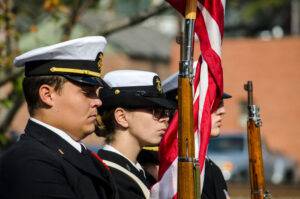 Because there are so few schools offering NROTC, it’s considered very competitive. You have to pick five possible schools and select your major before application. The Navy ranks majors in three different tiers; these can change depending on current needs in the Fleet. Tier 1 and Tier 2 have the highest priority, while Tier 3 come in down the list.
Because there are so few schools offering NROTC, it’s considered very competitive. You have to pick five possible schools and select your major before application. The Navy ranks majors in three different tiers; these can change depending on current needs in the Fleet. Tier 1 and Tier 2 have the highest priority, while Tier 3 come in down the list.
NROTC starts off at full throttle with the New Student Indoctrination at the Naval Station Great Lakes in Illinois, the Navy’s only boot camp. This lasts for about two weeks and dunks you in with daily drills, physical training, and Naval customs and courtesies.
Once you actually begin college, there will be one or two days a week you are expected to go through physical training and undergo classroom work in subjects such as:
- Naval history
- Naval Engineering and Weapons
- Leadership and ethics
In addition to the formal Naval Science instruction, you’ll be required to take certain other courses at college, even if they fall outside your major. These can include classes in calculus, communications, and military affairs. Each different option may have different coursework requirements, and different physical training standards.
Where NROTC really shines are the so-called Summer Cruise options available to middies during each summer of college. After your freshman year, you will attend CORTRAMID, a warfare community indoctrination program held in Norfolk or San Diego. You rotate through phases in:
- Naval Aviation: Physiology, orientation flights, simulator time
- Submarine Warfare: Damage control training, simulator time, underway exposure
- Surface Warfare: Underway exposure, simulator time
- Marine Corps: Land navigation, weapons training, obstacle course time
Your second summer involves real cruising: a month with the fleet, training at sea on surface ships or subs. Marine Option midshipmen embed with USMC units on land or amphibious training. Some are sent to the Mountain Warfare Training Center in the Sierra Nevadas for high-altitude survival and combat training. Nurse Option mids are sent on Navy Nurse Cruises, similar to other cruises but embedded with Navy medical units around the world.
Your final summer offers more of the same, but also more in-depth. You have more latitude in picking a sub, surface ship, or foreign exchange cruise. If you play your cards right, you could get a slot on a carrier or embedded with a special warfare unit. Marine Option first class mids attend OCS in Quantico for six weeks, putting them on the same plane as other incoming second lieutenants.
No matter which branch you pick, ROTC offers amazing opportunities to experience military life and pick a military career path while you are still going through college. It’s a great way to align your personal and professional interests with service to your country. And it is among the most fitting of ways to honor the ideal of the well-educated citizen soldier, defending freedom and contributing to society at the same time.





